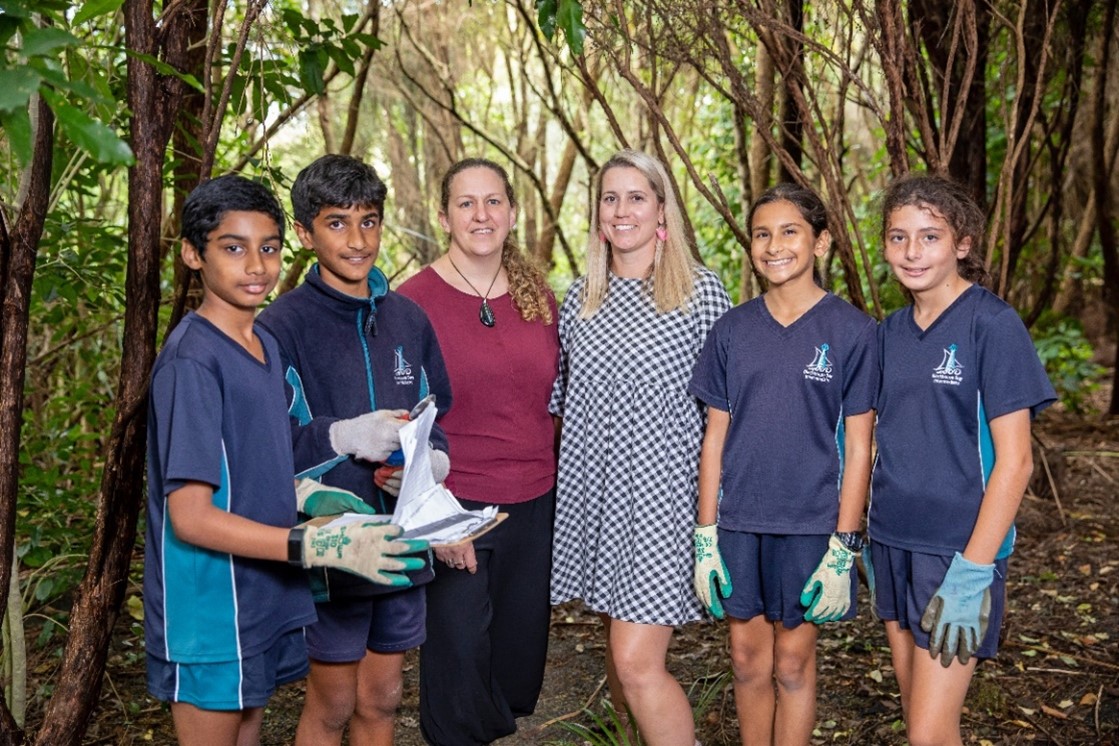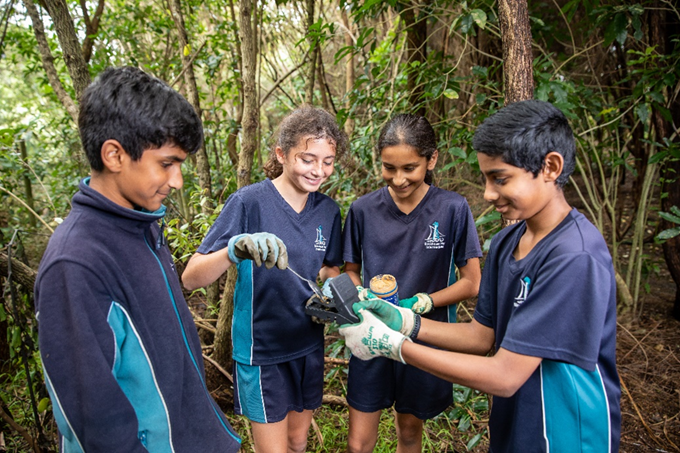Building a strong connection between a school and its surrounding environment has a raft of benefits, for both the people and the places. The students not only learn about what is around them and why it’s precious, but also how they can take care of it and inspire others to do the same.
Auckland Council is supporting schools to learn about the environment within their school grounds and the local community using funding from the Natural Environment Targeted Rate (NETR). Blockhouse Bay Intermediate is just one of the schools to benefit with nearly $1000 from NETR enabling council to provide the school with digital resources, and physical tools and equipment, such as native plants and traps, tracking tunnels and lures.
Protecting their school grounds and learning along the way
Blockhouse Bay Intermediate, which is a silver Enviroschool, has native bush and a stream on the edge of the school field, an outdoor classroom of sorts, where the planting and pest control is focused. Sustainable Schools advisor Frazer Dale also supported the kaupapa with three in-school sessions on how to use the tools provided. This included: an introduction to pests and monitoring, teaching students about pests and their impact, what we are trying to save by controlling pests, how to monitor for both native and pest species, trapping including Health and Safety, how and where to set traps and how to check them and a session on planting, including native plant identification, and the benefit of plants, and planting for restoration. Both the trapping and planting lessons included a practical session, setting traps and tracking tunnels in the bush, and planting 60 eco-sourced native plants including kawakawa, wharariki (flax), koromiko (hebe), ti kouka (cabbage tree) and nikau palms.
“The students wanted to investigate what native species they had in their school grounds. They then wanted to control pests so the native species could thrive,” says Frazer.
Blockhouse Bay Intermediate teacher Sarah-Marie Ward worked with the students on the pest control and planting for the last term of 2022, which meant checking five traps twice a week, resetting them with peanut butter lures, and occasionally moving them around.
She says it was very much student-led, and she “just recorded the findings and the children did all the trap handling as they had been trained previously. They knew where to set the traps and how often to check them, they did all the monitoring. I just chaperoned and recorded dates.
“The students learn about pest control and the ecosystem in the bush, which broadens their knowledge of our environment and gives them a sense of ownership. They were very excited to bury the rat we caught!”
The work is going to continue this year, led by new science teacher Laura Hillier with Sarah-Marie’s support.
Senior Sustainable Schools advisor for the Whau Local Board area at the time, Liz Peterson, says “it’s about educating rangatahi in te taiao, educating them about te taiao and then educating for te taiao. Teachers like Tonya, Sarah-Marie and Laura are doing an amazing job embedding sustainability and regeneration of te taiao into the education of future generations and to help grow our future citizens understanding, skills and motivation to develop solutions, act as guardians, and advocate for a healthy environment and society.”

Connecting with the Whau River and beyond
The work at the school also connects them directly to the ecological jewels around the area as the stream near the school’s boundary is part of the Avondale Stream catchment and flows into the Whau River, then out into the inner harbour between Te Atatū and Pt Chevalier. This creates a physical link between the school and the surrounding environments and it’s a link that Tonya Wyatt, former science teacher at the school and now Eco-Coordinator at Te Whau Pathway Project, is cultivating in her new role, connecting rangatahi with the pathway, which is a 12km shared path along the river between Te Atatū and New Lynn. Tonya’s role is funded by Auckland Council, through a contract with EcoMatters.
This work includes doing pest control and planting with students, and linking this to the curriculum, with Tonya going into Blockhouse Bay classrooms to teach students about the ecology and history of the Whau before their visits. This included preparing for a kayaking field trip for a group of year 8 students, who studied maps to see where the river flowed, and how it connected to their own lives, noting where their school, homes and other landmarks were in comparison. As well as the ecological features of the river, they learnt about its history as a traditional and important transportation route and gathering spot to talk and do business, what food was grown in the area and the importance of the clay soils. They also learnt the te reo Māori names for places and their significance, e.g. Kelston - Onewherowhero (red soil) and created their own artistic maps.
The kayaking trips are run by HOOPLA, a social enterprise organisation that focuses on place advocacy and community engagement, with Auckland Sea Kayaks. HOOPLA also receives council funding. Being on the water rather than beside gives students a different perspective of the area, the plants that grow there, and even the built environment like the pylons, and their purpose.
“We try to give them a real sense of place, and instil in them the value of kaitiakitanga,” says Tonya.
“Our main aim is to for them to go home and tell their parents about it and maybe even take them down there to share it."


